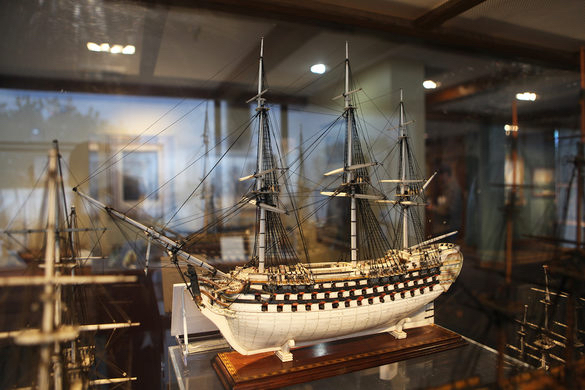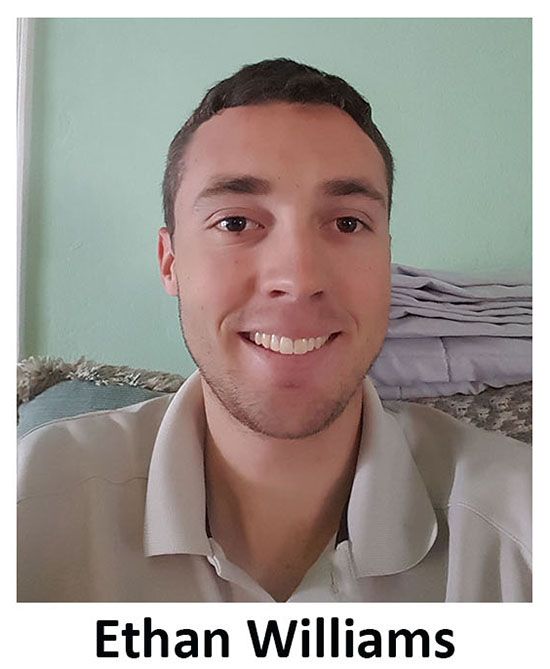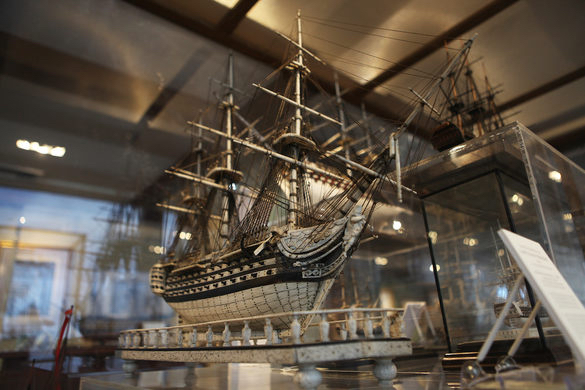 Dec. 17, 2019 — Hundreds of prisoners sat shoulder to shoulder in the foul, dark bowels of the hollowed out ship, sick, dirty and hungry. Yet even in their misery, they were compelled to create intricate model ships from the animal bones left over from their scant meals.
Dec. 17, 2019 — Hundreds of prisoners sat shoulder to shoulder in the foul, dark bowels of the hollowed out ship, sick, dirty and hungry. Yet even in their misery, they were compelled to create intricate model ships from the animal bones left over from their scant meals.
These “bone ships” constructed by 18th century French prisoners during the Napoleonic Wars on display at the Channel Islands Maritime Museum will soon include historical context researched and provided by CSU Channel Islands (CSUCI) History major Ethan Williams.
Assistant Professor of History Robin Mitchell, Ph.D., his faculty mentor, made it happen after she became aware that the director of the museum wanted to enhance the exhibit with a more detailed background, and was in need of a historian. Mitchell, who specializes in French history, thought Williams would be a perfect choice to help her with the research.
“It was a huge honor and I don’t think I could have done it without Dr. Mitchell’s guidance,” Williams said. “Just to have someone who is able to guide me through the research and show me the next step. Once I was able to string the research together, she showed me how to put my research in the context of the time period.”
Williams, 21, of Burbank, is the first in his family to attend college, so he hadn’t been exposed much to research before coming to CSUCI, but knew he enjoyed learning.
“I chose history as a major because it allows me to learn about stuff I didn’t know about before,” he said.
 When Mitchell began teaching Williams in class, she noticed how bright and eager he was, and how he seemed to have a knack for research.
When Mitchell began teaching Williams in class, she noticed how bright and eager he was, and how he seemed to have a knack for research.
“He’s intuitive and compassionate as a researcher and he took a leadership role,” Mitchell said. “Students respected him.”
After Mitchell applied for and received a faculty/student research grant, Williams dove into the project, fascinated, and learned how the prisoners’ creativity transcended their circumstances in these hollowed-out British man-of-war ships, called “hulks,” which were used as prisons during the Napoleonic Wars between 1793 and 1815.
 “These prisoners were crammed beneath the decks and the guards would close the portholes at night so the prisoners couldn’t escape. When they opened them in the morning, they would have to jump back from the odor,” he said. “And from that come these model ships the prisoners made from the bones left over from their meals. Some are real small and others are the size of a desk table. It’s amazing that something so light could come out of such a dark time.”
“These prisoners were crammed beneath the decks and the guards would close the portholes at night so the prisoners couldn’t escape. When they opened them in the morning, they would have to jump back from the odor,” he said. “And from that come these model ships the prisoners made from the bones left over from their meals. Some are real small and others are the size of a desk table. It’s amazing that something so light could come out of such a dark time.”
When it was time to present the research to the museum director, Mitchell said she could not have been more proud of Williams.
“What I witnessed was Ethan being able to answer every question the museum director asked,” Mitchell said. “I got to sit there like a proud elder watching this young man become the scholar he is. I can’t tell you how proud I was to have him represent the History program, and the University.”
After he graduates in 2020, Williams plans on pursuing his master’s degree and then aspires to a career in research — perhaps archiving for a government entity such as the Smithsonian.
“I was so proud watching this young man who was like, ‘yeah, research…whatever,’ turn into a scholar,” Mitchell said. “His research was methodical and beautiful and really told a story. I think he now sees himself as a historian because that’s what he is. What more could I, as an educator, ask for?”
